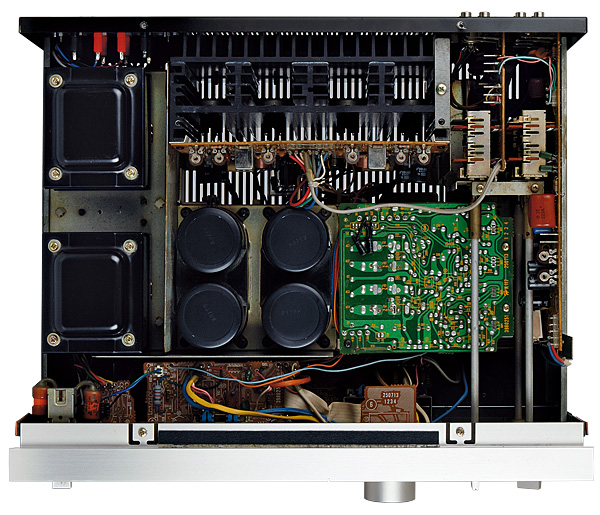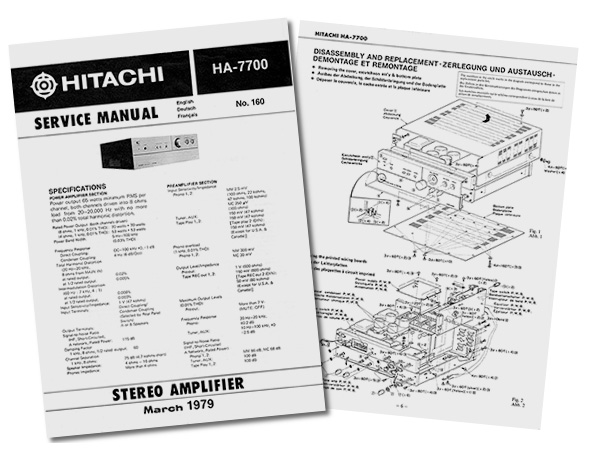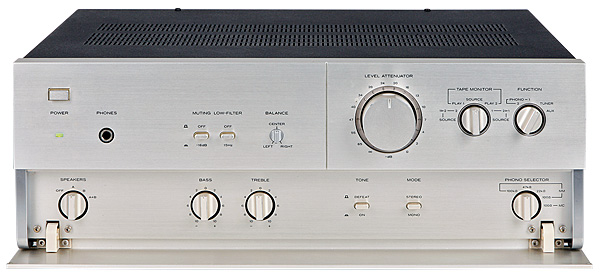Hitachi HA-7700 amplifier Page 2
Our review sample had its loudspeaker terminals changed from bare-wire clamps to 4mm sockets – no bad thing from the point of view of compatibility with modern cables, like the Chord Odyssey 2 runs that I use. An external link is fitted that breaks the connection between the pre and power amplifier sections, while adjacent to this can be found a switch that selects the input coupling mode for the power amp (DC or condenser coupled).

With the links in place the former position is the one to use, since there is an effective DC block at the output of the internal preamplifier. If an external preamplifier is used this setting must be used with caution, since the response of the power stages runs from 0-100kHz. Even a small DC error term in the external preamplifier's output could lead to the woofers in the loudspeakers being ruined.
![]() Tim Listens
Tim Listens
The amplifier switched on silently with no pops or clicks from the loudspeakers. It took a few seconds for the protection relay to cut in with a gentle tick, then the amp was ready to go. Although plausible right from the off, I found that the sound of the HA-7700 became smoother and more fluid once the output stage had reached full working temperature. This only takes 20 minutes or so, and is well worth the wait.
It's in the bass that this amplifier reveals its strengths. The lowest registers are quite lean, yet it is also apparent that large reserves of power exist down there. This separates the HA-7700 from the SonyTA-F70, a natural rival for the HA-7700 both when new and on today's vintage market. Where the Sony is big and tubby-sounding, the Hitachi is tight and fast.
True, at first the HA-7700 can sound a tad dry, but the precision and drive that it offers suggests that a well chosen compromise has been struck. Japanese amplifiers of this era are often criticised for having an overly prominent midband, which makes some types of music sound bland while lending an unwelcome glare to spoken-word material. This effect has been avoided in the case of the HA-7700, which from a tonal point of view is essentially neutral.
The treble too, is well positioned, being smooth and well defined without a hint of coarseness. This is an even-handed unit. It may lack the whizz-bang dynamics of, say, the JVC A-X4 [HFN Oct '17] but I never had the impression that anything was being added to the music or being concealed.
When you have a big amplifier to audition you naturally want to take the opportunity to make a lot of noise, so I tried the HA-7700 with some up-tempo material. Chris Rea's Road To Hell album [WEA 2292-46285-2] really requires a system that is both powerful and capable of resolving the recording's underlying quality. The Cyrus CD8 SE 2 CD player used for the listening made for such a set-up.

Low-End Grip
Skipping Part 1 of the title track and going straight to Part 2 (doesn't everyone?) I was rewarded with the grumbling low bass kept firmly in check, allowing the melodic guitar lines that define the piece to come over beautifully. I was also impressed at how raising the volume did not seem to degrade the overall sense of definition – until the amp was working very hard indeed. Paired sympathetically with sensitive speakers the HA-7700 would seem to offer more than enough power for any domestic listening requirement.
Also impressive was the contrast that the amp could generate. It's a quiet design, both electrically and mechanically, so when the music faded into softer passages there was no apparent hiss or hum to spoil the illusion.
More orchestral in nature, 'Winter' by Tori Amos (from Little Earthquakes; East West 7567-82358-2) showed how the HA-7700amplifier could construct expansive soundscapes with real front-to-back projection. Vocal integration was fine, the whole album revealing neither prominence nor recess in this key band of frequencies.
Solo piano, a ruthless revealer of under-performing hi-fi hardware, was thankfully reproduced without serious mishap. A bit more warmth around the swirling strings would not have gone amiss, although I admit this is really a matter of taste. That aside, I found the HA-7700 a difficult amplifier to fault. It looks good, sounds good, does everything one could want and causes very little trouble. Although not tested here exhaustively, the built-in phono stage is pretty good too.
Buying Secondhand
The HA-7700 did not sell in large numbers in the UK so finding one can be difficult. But as these are supremely durable units, the majority of those which do find their way onto the market should still be functional. External condition is therefore the key when it comes to buying secondhand. The large flat alloy fascia means dents and scuffs have nowhere to hide while the high-quality metal knobs are not always fully attached. Another weak point centres on the hinges for the flap, which can break should the latter fall open while the unit is being carried.

Under the lid, the loudspeaker relay uses duplicated contacts in an attempt to ward off potential problems, but it is still worth cleaning if you want to obtain the best results. However, the amplifier's internal layout means that this is not the easiest of tasks.
There are a multiplicity of internal adjustments for bias and DC balance which must be completed by following the procedure laid out in in the manual. But the components used were all of the highest quality and none warrants replacement merely on a whim.
It has been noted that the fusible-type resistors in the power amplifier circuit can drift upwards in value, making the correct points of adjustment (and therefore the full measure of performance) impossible to achieve. A check with a meter on all seven is strongly advised, since in most cases the unit will apparently work even when they are faulty.
Hi-Fi News Verdict
Hitachi isn't widely recognised as a big league hi-fi manufacturer these days, but on this showing the company demands to be taken seriously. With a high standard of build and reputedly excellent reliability, this amplifier deserved to be more popular in its day. It now makes a fine alternative to the more obvious choices and, if bought well, should still give many years of trouble free enjoyment.


















































